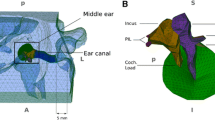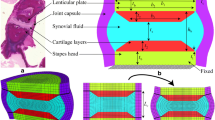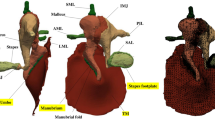Abstract
We present a finite-element model of the gerbil middle ear that, using a set of baseline parameters based primarily on a priori estimates from the literature, generates responses that are comparable with responses we measured in vivo using multi-point vibrometry and with those measured by other groups. We investigated the similarity of numerous features (umbo, pars-flaccida and pars-tensa displacement magnitudes, the resonance frequency and break-up frequency, etc.) in the experimental responses with corresponding ones in the model responses, as opposed to simply computing frequency-by-frequency differences between experimental and model responses. The umbo response of the model is within the range of variability seen in the experimental data in terms of the low-frequency (i.e., well below the middle-ear resonance) magnitude and phase, the main resonance frequency and magnitude, and the roll-off slope and irregularities in the response above the resonance frequency, but is somewhat high for frequencies above the resonance frequency. At low frequencies, the ossicular axis of rotation of the model appears to correspond to the anatomical axis but the behaviour is more complex at high frequencies (i.e., above the pars-tensa break-up). The behaviour of the pars tensa in the model is similar to what is observed experimentally in terms of magnitudes, phases, the break-up frequency of the spatial vibration pattern, and the bandwidths of the high-frequency response features. A sensitivity analysis showed that the parameters that have the strongest effects on the model results are the Young’s modulus, thickness and density of the pars tensa; the Young’s modulus of the stapedial annular ligament; and the Young’s modulus and density of the malleus. Displacements of the tympanic membrane and manubrium and the low-frequency displacement of the stapes did not show large changes when the material properties of the incus, stapes, incudomallear joint, incudostapedial joint, and posterior incudal ligament were changed by ±10 % from their values in the baseline parameter set.

















Similar content being viewed by others
Notes
In the previous gerbil model from our group (Elkhouri et al. 2006), based on magnetic-resonance-microscopy images, the inferior part of the manubrium was narrower than it should have been.
Instead of this bony attachment, Elkhouri et al. (2006) used a ligament to connect the malleus to the cavity wall.
In the model by Elkhouri et al. (2006), this ligament was considered to be composed of two bundles.
In the model of Elkhouri et al. (2006) the stapedial annular ligament was modelled by shell elements and the rotational degrees of freedom of its nodes were fixed by mistake. That boundary condition allowed only piston-like motion of the stapes.
The very high value of 20 GPa reported in Table 3 of Volandri et al. (2011) was a typographical error (GPa rather than MPa) in the original paper by Gentil et al. (2005) (personal communication with Gentil). The very low value of 1.5 MPa used by Lesser and Williams (1988) was for a 2-D model. The very low values used by Funnell and Laszlo (1978) and Funnell (2001) for E c were intended to be extreme examples of anisotropy, not realistic estimates. The very low values used by Ferrazzini (2003) were for a pars-tensa model that was overly thick and was not smooth.
References
Aernouts J, Dirckx JJJ (2011) Elastic characterization of the gerbil pars flaccida from in situ inflation experiments. Biomech Model Mechanobiol 10(5):727–741
Aernouts J, Dirckx JJJ (2012) Static versus dynamic gerbil tympanic membrane elasticity: derivation of the complex modulus. Biomech Model Mechanobiol 11(6):829–840
Aernouts J, Soons JAM, Dirckx JJJ (2010) Quantification of tympanic membrane elasticity parameters from in situ point indentation measurements: validation and preliminary study. Hear Res 263(1–2):177–182
Aernouts J, Aerts JRM, Dirckx JJJ (2012) Mechanical properties of human tympanic membrane in the quasi-static regime from in situ point indentation measurements. Hear Res 290(1–2):45–54
Agache PG, Monneur C, Leveque JL, Rigal JD (1980) Mechanical properties and Young’s modulus of human skin in vivo. Arch Dermatol Res 269(3):221–232
Beranek LL (1954) Acoustics. Acoust. Soc. Am, New York
Bergevin C, Olson ES (2014) External and middle ear sound pressure distribution and acoustic coupling to the tympanic membrane. J Acoust Soc Am 135(3):1294–1312
Buytaert JAN, Salih WHM, Dierick M, Jacobs P, Dirckx JJJ (2011) Realistic 3D computer model of the gerbil middle ear, featuring accurate morphology of bone and soft tissue structures. J Assoc Res Otolaryngol 12(6):681–696
Cheng T, Dai C, Gan RZ (2007) Viscoelastic properties of human tympanic membrane. Ann Biomed Eng 35(2):305–314
Chole RA, Kodama K (1989) Comparative histology of the tympanic membrane and its relationship to cholesteatoma. Ann Otol Rhinol Laryngol 98(10):761–766
Cohen YE, Bacon CK, Saunders JC (1992) Middle ear development III: morphometric changes in the conducting apparatus of the Mongolian gerbil. Hear Res 62(2):187–193
Daphalapurkar NP, Dai C, Gan RZ, Lu H (2009) Characterization of the linearly viscoelastic behavior of human tympanic membrane by nanoindentation. J Mech Behav Biomed Mater 2(1):82–92
Davies DV (1948) A note on the articulations of the auditory ossicles and related structures. J Laryngol Otol 62(08):533–536
de La Rochefoucauld O, Decraemer WF, Khanna SM, Olson ES (2008) Simultaneous measurements of ossicular velocity and intracochlear pressure leading to the cochlear input impedance in gerbil. J Assoc Res Otolaryngol 9(2):161–177
Deb K (2014) Multi-objective Optimization. In: Burke EK, Kendall G (eds) Search methodologies. Springer, US, pp 403–449
Decraemer WF, Maes MA, Vanhuyse VJ (1980) An elastic stress-strain relation for soft biological tissues based on a structural model. J Biomech 13(6):463–468
Decraemer WF, de Rochefoucauld OL, Dong W, Khanna SM, Dirckx JJJ, Olson ES (2007) Scala vestibuli pressure and three-dimensional stapes velocity measured in direct succession in gerbil. J Acoust Soc Am 121(5):2774–2791
Decraemer WF, Dirckx JJJ, Maftoon N, Funnell WRJ (2010) Simulating large deformations of the gerbil pars flaccida to determine its material properties. 33rd Midwinter Research Meeting. Association for research in otolaryngology, Anaheim
Decraemer WF, Maftoon N, Dirckx JJJ, Funnell WRJ (2011) The effects of the asymmetric shape of the tympanic membrane on the asymmetry of ossicular displacements for positive and negative static pressures. 34th ARO MidWinter Meeting. Retrieved from http://www.aro.org/archives/2011/2011_52_1305771725.html
Decraemer WF, Rochefoucauld de OL, Funnell WRJ, Olson ES (2014) Three-dimensional vibration of the malleus and incus in the living gerbil. J Assoc Res Otolaryngol 1–28. doi:10.1007/s10162-014-0452-1
Elkhouri N, Liu H, Funnell WRJ (2006) Low-frequency finite-element modeling of the gerbil middle ear. J Assoc Res Otolaryngol 7(4):399–411
Fay J, Puria S, Decraemer WF, Steele C (2005) Three approaches for estimating the elastic modulus of the tympanic membrane. J Biomech 38(9):1807–1815
Fay JP, Puria S, Steele CR (2006) The discordant eardrum. Proc Natl Acad Sci 103(52):19743–19748
Ferrazzini M (2003) Virtual middle ear: a dynamic mathematical model based on the finite element method. ETH Zürich. Retrieved from http://cds.cern.ch/record/894552
Fumagalli Z (1949) Ricerche morfologiche sull’apparato di trasmissione del suono. Sound-conducting apparatus: a study of morphology. Istituto per la diffusione di opere scientifiche, Milano
Funnell WRJ (2001) High-frequency time-domain behaviour of a finite-element model of the eardrum. Presented at the 24th Midwinter Research Meeting of the Association for Research in Otolaryngology, St. Petersburg Beach, FL. Retrieved from http://audilab.bme.mcgill.ca/AudiLab/research.html
Funnell WRJ, Decraemer WF (1996) On the incorporation of moiré shape measurements in finite‐element models of the cat eardrum. J Acoust Soc Am 100(2):925–932
Funnell WRJ, Laszlo CA (1978) Modeling of the cat eardrum as a thin shell using the finite-element method. J Acoust Soc Am 63:1461
Funnell WRJ, Laszlo CA (1982) A critical review of experimental observations on ear-drum structure and function. ORL 44(4):181–205
Funnell WRJ, Decraemer WF, Khanna SM (1987) On the damped frequency response of a finite-element model of the cat eardrum. J Acoust Soc Am 81:1851
Funnell WRJ, Decraemer WF, Von Unge M, Dirckx JJJ (1999) Finite-element modelling of the gerbil eardrum and middle ear. 22nd ARO MidWinter Meeting. Retrieved from http://www.aro.org/archives/1999/799.html
Funnell WRJ, Decraemer WF, Von Unge M, Dirckx JJJ (2000) Finite-element modelling of the gerbil eardrum and middle ear. 23rd ARO MidWinter Meeting. Retrieved from http://www.aro.org/archives/1999/799.html
Funnell WRJ, Maftoon N, Decraemer WF (2012) Mechanics and modelling for the middle ear. Retrieved March 3, 2013 from http://audilab.bme.mcgill.ca/∼funnell/AudiLab/mammie/mammie.pdf
Funnell WRJ, Maftoon N, Decraemer WF (2013) Modeling of middle-ear mechanics. In: Puria S, Fay RR, Popper AN (eds) The middle ear - science, otosurgery, and technology
Gaihede M, Liao D, Gregersen H (2007) In vivo areal modulus of elasticity estimation of the human tympanic membrane system: modelling of middle ear mechanical function in normal young and aged ears. Phys Med Biol 52(3):803–814
Gan RZ, Yang F, Zhang X, Nakmali D (2011) Mechanical properties of stapedial annular ligament. Med Eng Phys 33(3):330–339
Gea SLR, Decraemer WF, Funnell RWJ, Dirckx JJJ, Maier H (2009) Tympanic membrane boundary deformations derived from static displacements observed with computerized tomography in human and gerbil. J Assoc Res Otolaryngol 11(1):1–17
Geerligs M, van Breemen L, Peters G, Ackermans P, Baaijens F, Oomens C (2011) In vitro indentation to determine the mechanical properties of epidermis. J Biomech 44(6):1176–1181
Gentil F, Jorge RN, Ferreira AJM, Parente MPL, Moreira M, Almeida E (2005) Biomechanical study of middle ear. Proc. COMPLAS VIII (Vol. 2, pp. 785–788). Retrieved from http://congress.cimne.upc.es/complas05/admin/Files/FilePaper/p313.pdf
Geuzaine C, Remacle J-F (2009) Gmsh: a 3-D finite element mesh generator with built-in pre- and post-processing facilities. Int J Numer Methods Eng 79(11):1309–1331
Ghadarghadar N, Agrawal SK, Samani A, Ladak HM (2013) Estimation of the quasi-static Young’s modulus of the eardrum using a pressurization technique. Comput Methods Prog Biomed 110(3):231–239
Greaves GN, Greer AL, Lakes RS, Rouxel T (2011) Poisson’s ratio and modern materials. Nat Mater 10(11):823–837
Harty M (1953) Elastic tissue in the middle-ear cavity. J Laryngol Otol 67(12):723–729
Hesabgar SM, Marshall H, Agrawal SK, Samani A, Ladak HM (2010) Measuring the quasi-static Young’s modulus of the eardrum using an indentation technique. Hear Res 263(1–2):168–176
Huang G, Gan RZ, Lu H, Daphalapurkar NP (2008) A method for measuring linearly viscoelastic properties of human tympanic membrane using nanoindentation. J Biomech Eng 130(1):014501–014501
Kinsler LE, Frey AR, Coppens AB, Sanders JV (1999) Fundamentals of Acoustics. Wiley and Sons, New York
Kirikae I (1960) The structure and function of the middle ear. University of Tokyo Press, Tokyo
Kuypers LC, Dirckx JJJ, Decraemer WF, Timmermans J-P (2005) Thickness of the gerbil tympanic membrane measured with confocal microscopy. Hear Res 209(1–2):42–52
Ladak HM, Funnell WRJ (1996) Finite-element modeling of the normal and surgically repaired cat middle ear. J Acoust Soc Am 100:933
Lee CY, Rosowski JJ (2001) Effects of middle-ear static pressure on pars tensa and pars flaccida of gerbil ears. Hear Res 153(1-2):146–163
Lesser THJ, Williams KR (1988) The tympanic membrane in cross section: a finite element analysis. J Laryngol Otol 102(03):209–214
Lim DJ (1968a) Tympanic membrane: electron microscopic observation part I: pars tensa. Acta Otolaryngol 66(1-6):181–198
Lim DJ (1968b) Tympanic membrane part II: pars flaccida. Acta Otolaryngol 66(1-6):515–532
Lim DJ (1970) Human tympanic membrane: an ultrastructural observation. Acta Otolaryngol 70(3):176–186
Luo H, Dai C, Lu H, Gan RZ (2009) Measurement of Young’s modulus of human tympanic membrane at high strain rates. J Biomech Eng 131(6):064501–064501
Lynch TJI, Nedzelnitsky V, Peake WT (1982) Input impedance of the cochlea in cat. J Acoust Soc Am 72(1):108–130
Maftoon N, Nambiar S, Funnell WRJ, Decraemer WF, Daniel SJ (2011) Experimental and modelling study of gerbil tympanic-membrane vibrations. 34th ARO MidWinter Meeting. Retrieved from http://www.aro.org/archives/2011/2011_46_1305771725.html
Maftoon N, Funnell WRJ, Daniel SJ, Decraemer WF (2013) Experimental study of vibrations of gerbil tympanic membrane with closed middle-ear cavity. J Assoc Res Otolaryngol. Accepted.
Maftoon N, Funnell WRJ, Daniel SJ, Decraemer WF (2014) Effect of opening middle-ear cavity on vibrations of gerbil tympanic membrane. J Assoc Res Otolaryngol 15(3):319–334
Motallebzadeh H, Charlebois M, Funnell WRJ (2013) A non-linear viscoelastic model for the tympanic membrane. J Acoust Soc Am 134(6):4427–4434
Newmark NM (1959) A method of computation for structural dynamics. J Eng Mech Div 85(7):67–94
Nicolas G, Fouquet T (2013) Adaptive mesh refinement for conformal hexahedralmeshes. Finite Elem Anal Des 67:1–12
Nummela S (1995) Scaling of the mammalian middle ear. Hear Res 85(1-2):18–30
Overstreet EHI, Ruggero MA (2002) Development of wide-band middle ear transmission in the Mongolian gerbil. J Acoust Soc Am 111:261
Qi L, Mikhael CS, Funnell WRJ (2004) Application of the Taguchi method to sensitivity analysis of a middle-ear finite-element model. Proc 28th Ann Conf Can Med Biol Eng Soc 153–156
Rabbitt RD, Holmes MH (1986) A fibrous dynamic continuum model of the tympanic membrane. J Acoust Soc Am 80(6):1716–1728
Rabbitt RD, Holmes MH (1988) Three‐dimensional acoustic waves in the ear canal and their interaction with the tympanic membrane. J Acoust Soc Am 83(3):1064–1080
Ravicz ME, Rosowski JJ, Voigt HF (1992) Sound-power collection by the auditory periphery of the Mongolian gerbil Meriones unguiculatus. I: middle-ear input impedance. J Acoust Soc Am 92(1):157–177
Ravicz ME, Cooper NP, Rosowski JJ (2008) Gerbil middle-ear sound transmission from 100 Hz to 60 kHz. J Acoust Soc Am 124:363
Rosowski JJ, Lee CY (2002) The effect of immobilizing the gerbil’s pars flaccida on the middle-ear’s response to static pressure. Hear Res 174(1-2):183–195
Rosowski JJ, Teoh SW, Flandermeyer DT (1997) The effect of the pars flaccida of the tympanic membrane on the ear’s sensitivity to sound. In: Lewis ER, Long GR, Lyon RF, Narins PM, Steele CR, Hect-Poiner E (eds) Diversity in auditory mechanics. World Scientific, New Jersey, pp 129–135
Rosowski JJ, Ravicz ME, Teoh SW, Flandermeyer D (1999) Measurements of middle-ear function in the Mongolian gerbil, a specialized mammalian ear. Audiol Neurootol 4(3-4):129–136
Salih WHM, Buytaert JAN, Aerts JRM, Vanderniepen P, Dierick M, Dirckx JJJ (2012) Open access high-resolution 3D morphology models of cat, gerbil, rabbit, rat and human ossicular chains. Hear Res 284(1–2):1–5
Sim JH, Puria S, Steele CR (2007) Calculation of inertial properties of the malleus-incus complex from micro-CT imaging. J Mech Mater Struct 2:1515–1524
Soons JA, Aernouts J, Dirckx JJ (2010) Elasticity modulus of rabbit middle ear ossicles determined by a novel micro-indentation technique. Hear Res 263(1-2):33–37
Sun Q, Gan RZ, Chang KH, Dormer KJ (2002) Computer-integrated finite element modeling of human middle ear. Biomech Model Mechanobiol 1(2):109–122
Teoh SW, Flandermeyer DT, Rosowski JJ (1997) Effects of pars flaccida on sound conduction in ears of Mongolian gerbil: acoustic and anatomical measurements. Hear Res 106(1-2):39–65
Timoshenko SP, Woinowsky-Krieger S (1959) Theory of plates and shells (Second.). McGraw-Hill, New York
Tuck-Lee JP, Pinsky PM, Steele CR, Puria S (2008) Finite element modeling of acousto-mechanical coupling in the cat middle ear. J Acoust Soc Am 124:348
Volandri G, Di Puccio F, Forte P, Carmignani C (2011) Biomechanics of the tympanic membrane. J Biomech 44(7):1219–1236
von Békésy G (1960) Experiments in hearing. McGraw-Hill, New York
Wada H, Metoki T, Kobayashi T (1992) Analysis of dynamic behavior of human middle ear using a finite-element method. J Acoust Soc Am 92(6):3157
Wang YC, Lakes RS (2005) Composites with inclusions of negative bulk modulus: extreme damping and negative Poisson’s ratio. J Compos Mater 39(18):1645–1657
Zhang X, Gan RZ (2011) Experimental measurement and modeling analysis on mechanical properties of incudostapedial joint. Biomech Model Mechanobiol 10(5):713–726
Acknowledgments
The authors would like to thank the editors and the three anonymous reviewers who helped us to improve this paper. This work was supported in part by the Canadian Institutes of Health Research, the Fonds de recherche en santé du Québec, the Natural Sciences and Engineering Research Council (Canada), the Montréal Children’s Hospital Research Institute, the McGill University Health Centre Research Institute and the Research Fund of Flanders (Belgium). Computations were made on the supercomputer Guillimin of McGill University, managed by Calcul Québec and Compute Canada; the operation of this supercomputer is funded by the Canada Foundation for Innovation, NanoQuébec, the Réseau de Médecine Génétique Appliquée and the Fonds de recherche du Québec—Nature et technologies. We thank Clarinda Northrop for providing a collection of gerbil histological slides and Yu Xin Shen for digitizing and cataloguing the collection.
Author information
Authors and Affiliations
Corresponding author
Rights and permissions
About this article
Cite this article
Maftoon, N., Funnell, W.R.J., Daniel, S.J. et al. Finite-Element Modelling of the Response of the Gerbil Middle Ear to Sound. JARO 16, 547–567 (2015). https://doi.org/10.1007/s10162-015-0531-y
Received:
Accepted:
Published:
Issue Date:
DOI: https://doi.org/10.1007/s10162-015-0531-y




